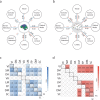Brain age prediction and deviations from normative trajectories in the neonatal connectome
- PMID: 39592647
- PMCID: PMC11599754
- DOI: 10.1038/s41467-024-54657-5
Brain age prediction and deviations from normative trajectories in the neonatal connectome
Abstract
Structural and functional connectomes undergo rapid changes during the third trimester and the first month of postnatal life. Despite progress, our understanding of the developmental trajectories of the connectome in the perinatal period remains incomplete. Brain age prediction uses machine learning to estimate the brain's maturity relative to normative data. The difference between the individual's predicted and chronological age-or brain age gap (BAG)-represents the deviation from these normative trajectories. Here, we assess brain age prediction and BAGs using structural and functional connectomes for infants in the first month of life. We use resting-state fMRI and DTI data from 611 infants (174 preterm; 437 term) from the Developing Human Connectome Project (dHCP) and connectome-based predictive modeling to predict postmenstrual age (PMA). Structural and functional connectomes accurately predict PMA for term and preterm infants. Predicted ages from each modality are correlated. At the network level, nearly all canonical brain networks-even putatively later developing ones-generate accurate PMA prediction. Additionally, BAGs are associated with perinatal exposures and toddler behavioral outcomes. Overall, our results underscore the importance of normative modeling and deviations from these models during the perinatal period.
© 2024. The Author(s).
Conflict of interest statement
Competing interests: The authors declare no competing interests.
Figures




Update of
-
Brain age prediction and deviations from normative trajectories in the neonatal connectome.bioRxiv [Preprint]. 2024 Apr 25:2024.04.23.590811. doi: 10.1101/2024.04.23.590811. bioRxiv. 2024. Update in: Nat Commun. 2024 Nov 26;15(1):10251. doi: 10.1038/s41467-024-54657-5. PMID: 38712238 Free PMC article. Updated. Preprint.
References
Publication types
MeSH terms
Grants and funding
LinkOut - more resources
Full Text Sources
Medical
Miscellaneous

